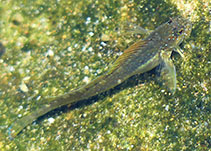| Family: |
Blenniidae (Combtooth blennies), subfamily: Salariinae |
| Max. size: |
16 cm SL (male/unsexed); 13.1 cm SL (female) |
| Environment: |
reef-associated; marine; depth range 0 - 3 m |
| Distribution: |
Western Indian Ocean: 3 mi north of Muqadisho, Somalia, south to Bolito Bay, Natal, South Africa; St. Pierrw (Seychelles); Nossi Be, Madagascar, Juan de Nova Island; Mauritius. Eastern Indian Ocean: Christmas Island. Pacific Ocean: New Hebrides, Niuafo'ou, Samoa, Niue, Marquesas, Saipan Islands. |
| Diagnosis: |
Dorsal spines (total): 12-14; Dorsal soft rays (total): 20-22; Anal spines: 2-2; Anal soft rays: 20-22. Body of males with several paired bands; spots from mouth to nape and posterior part of body; dusky stripes on segmented portion of dorsal fin (Ref. 4404). Females with dusky bands on body; head, body and fins (except pelvic fins) covered with fine dark specs (Ref. 4404). |
| Biology: |
Adults are found in intertidal flats and rock shores (Ref. 90102). Oviparous. Eggs are demersal and adhesive (Ref. 205), and are attached to the substrate via a filamentous, adhesive pad or pedestal (Ref. 94114). Larvae are planktonic, often found in shallow, coastal waters (Ref. 94114). |
| IUCN Red List Status: |
Least Concern (LC); Date assessed: 27 March 2009 Ref. (130435)
|
| Threat to humans: |
harmless |
Source and more info: www.fishbase.org. For personal, classroom, and other internal use only. Not for publication.
